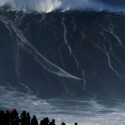What would happen if you obtained space-bending abilities and decided to test them out by placing Earth between the two asteroid belts in our Solar System? The short answer is you might be asking for a little dose of planetary extinction. Would we be forced to give up on celestial travel? How long before one of these belts’ asteroids is headed our way? And how big a space rock could we collide with?
Our Solar System has two asteroid belts. Closest to us is the Main Asteroid Belt. Located between Mars and Jupiter, its asteroids are primarily made of rock and stone. It’s estimated 16 of them have a diameter greater than 240 km (150 mi). The largest object in the belt is the dwarf planet Ceres. More on how this factors into the big picture later.
All the way in the back, beyond Neptune, lies the Kuiper Belt. A region filled with icy leftovers from the early days of the Solar System, some with a diameter of 100 km (62 mi) or more. Among them lives another dwarf planet, Pluto. So what would Earth’s fate be surrounded by not one, but two asteroid belts?
To understand the scale of this scenario, you first need to know what an astronomical unit is. One AU is the distance between the Earth and the Sun. The Kuiper Belt is 25 AU wide. Compared to that the Main Asteroid Belt, which is only one AU, seems pretty sparse. Let’s say you left their sizes as is and transported them next to Earth. The inner edge of the Kuiper Belt would be between Mars and us.
The Main Asteroid Belt’s outer edge would be situated between Earth and Venus. The Main Asteroid Belt, although the smaller of the two, would still extend itself over the Sun. Venus and Mercury would now orbit among its millions of rocky bodies. The Kuiper Belt, on the other side, would go even further. You’d find it draping itself over Mars, Jupiter, Saturn and Uranus.
Only Neptune would be left outside of the party, though not by much. How would this new arrangement look on a starry night? Quite unexciting, I’m afraid. Think of it this way. Pluto, the dwarf planet inside the Kuiper Belt, would now orbit at about three AU from us. Just shy of our current distance from Jupiter. Jupiter is an enormous gas planet, but is no more than a bright star to the naked eye.
So what can you expect to see of Pluto, which is only two-thirds the diameter of our Moon? A whole lot of nothing, really. Perhaps by this point you are realizing you used your powers irresponsibly. After all, it’d be crazy to travel to other planets within our Solar System now that they are surrounded by millions upon millions of scattered objects.
So would you be stuck on Earth forever? Well, no. There might be millions, even billions of rocks floating too close to our planet now. Luckily for you, asteroid belts aren’t that dense. The average distance between objects inside a belt is about one million km (600,000 mi). So you’d still be able to fulfill your dream of going to Mars one day.
That’s unless you squeezed the asteroid belts really tight. The entire Main Asteroid Belt would now fit between Earth and Venus, and the Kuiper Belt between Earth and Mars. Sure, we aren’t strangers to flying through junk. In 2021 alone there were about 23,000 pieces of debris larger than a softball orbiting the Earth. Only now we wouldn’t be surrounded by pieces left behind by broken satellites.
We’d have to deal with substantially larger chunks of all-natural material. The Kuiper Belt alone has hundreds of thousands of objects at least 100 km (60 mi) wide. Think about it. Hundreds of thousands of asteroids, each at least 10 times bigger than the one that wiped out the dinosaurs 66 million years ago. And in the Main Asteroid Belt, we’d be facing over a million rocks larger than 1 km (0.6 mi), on top of millions of other smaller ones.
So yeah. Space travel would be suspended indefinitely. Maybe we could at least use all those asteroids for something helpful. Like iron and nickel mining. Right? Not so fast. You’d be too busy dealing with asteroids bombarding Earth from all directions. You heard it right. The gravitational pull from our planet could attract objects from both of the surrounding belts.
At the lower end of the mass destruction scale, you’d have smaller asteroids capable of destroying an entire metropolis with the same amount of force as a nuclear bomb. Oh, and remember Ceres? The dwarf planet inside the Main Asteroid Belt? It is almost 100 times larger than the asteroid that led to the mass extinction of the dinosaurs.
One tiny cataclysmic bump into Earth and WHOOPS! There goes our planet, along with all life as we know it. Don’t play with the Solar System. Unless you plan on giving humanity a new home and not wipe all of us out in the process. You could try and terraform Mars.
Sources
- “Kuiper Belt Objects: Facts About The Kuiper Belt & Kbos”. Nola Taylor Tillman. 2019. space.com.
- “How Big Is Pluto? New Horizons Settles Decades-Long Debate”. 2015. nasa.gov.
- “Asteroid Belt: Facts & Formation”. Nola Taylor Tillman. 2017. space.com.
- “Distances Between The Planets Of The Solar System • The Planets”. 2022. theplanets.org.
- “Kuiper Belt”. 2022. solarsystem.nasa.gov.


























